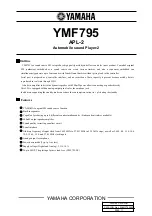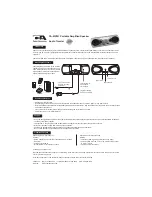
YMF795
-13-
Rest data
Default: 0000h
Index
b15 b14 b13
b12 b11
b10
b9
b8
b7
b6
b5
b4
b3
b2
b1
b0
$00h
0
0
1
1
0
0
CH1 CH0 VCHE TI3 TI2 TI1 TI0
VCH2 VCH1VCH0
CH1 - CH0 : Part setting
Using CH1 or 0 bit, set the part of each rest.
CH[1:0] Part
designation
00b 0
01b 1
10b 2
11b 3
TI3 - TI0 : Interval setting
These bits are used to set the interval time before the processing of the next note and rest.
The interval “48” represents the time for the whole note.
The following table is exactly the same as that for the note data.
TI [3:0]
Interval
0h 3
1h 2
2h 3
3h 4
4h 6
5h 8
6h 9
7h 12
8h 18
9h 24
Ah 48
Bh 1
Ch 16
Dh 24
Eh 36
Fh 48
VCHE, VCH2 – VCH0 : Timbre change function
Although the maximum number of timbres that can be simultaneously used is four, the timbre can be changed during
sound reproduction by setting these bits. Set VCHE to “1” and set a timbre number by using VCH2 to VCH0.
Switching of timbre in rest data is made according to the designated time of the sequence data. After the next note to
generate, the timbre in a part specified by CH0 and CH1 will be changed.
Make the change of a timbre after sound generation of a part to change is completely stopped.
The state at which sound generation is completely stopped is not a state where TK (sound length) is ended but a state
where release time of envelope is completed.
Note that unusual sound may be instantaneously generated if switching the timbre while sound generation is not
completely stopped.
If the timbre allocation is changed by using this function, the $30h register itself will be rewritten.
Summary of Contents for YMF795
Page 44: ...YMF795 44 External dimensions...
Page 45: ...YMF795...














































